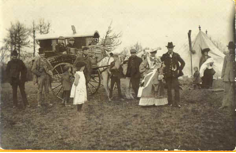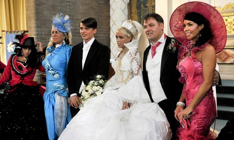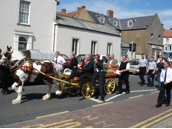Life events

Marriage
Most Gypsies are married in church or by a registrar. A traditional Romani marriage is still sometimes practised. The tradition was that young man attracted to young women will purchase two red handkerchiefs. Wearing one himself he will give the other to the girl. If she accepted him she will wear it showing she is betrothed. An essential part of a Romani marriage ceremony is the holding of hands while a Romani elder pronounces them man and wife before a gathering of relatives. This ceremony is then followed by one of many customs according to the locality in which the ceremony takes place. This includes from drinking from the same cup. The custom of jumping over a broomstick was also practised and originated with the Irish travellers. It was also common practice within Irish Traveller communities to marry within the family and marriages between first cousins were looked upon with favour. Morality among Gypsies is very high and there was punishment for unfaithful wives.
Modern Romani Gypsy Weddings

Photo: Channel 4/IUPN Big Fat Gypsy Wedding
The festivities celebrating a marriage can go on for several days. In the past the wedding itself was largely a symbolic ceremony before the family, with no religious significance. Civil and religious marriages have now become the ‘norm’. Wedding gifts almost always consist of money.
Considered 'on the shelf' at 20, many girls in Gypsy and Traveller communities get married soon after their 18th birthday with the support of their family. The Irish Traveller weddings are often visual spectacles: girl’s parade into church in enormous dresses that sometimes weigh more than the bride herself. Although the women may in some people’s eyes look sexually provocative there is a tradition of premarital chastity that is increasingly unusual in Britain today. This is a community that lives alongside but detached from mainstream society. It is a community of contrasts, living by centuries old religious and cultural traditions but at the same time embracing the gaudier extremes of the celebrity and fashion obsessed times in which we live. An expensive dress such as the one in the picture above would only be afforded by the most affluent Gypsies. Many Gypsies and travellers may not want or may not be able to afford this type of wedding and will celebrate in a style less flamboyant.

Death & Dying
The Gypsy community are a close tight knit group where family is considered a priority. When a member of the family becomes seriously ill or dies the relatives group together from near and far to support one another.
The death of a family member, regardless of age, is a devastating time. There are traditions to follow in order to commemorate the deceased passing.
The funeral arrangement will be undertaken by close family relatives, extended family and friends who will travel from far and wide to celebrate the life of their loved one, and to support those who have been bereaved.
When a person is dying many relatives will attend the bedside, it is necessary to show family solidarity. Touching the body of the deceased is discouraged because of the belief in cleanliness. There is inevitably a large crown at a traveller person’s funeral. There is often a procession to the church, passing places familiar to the deceased, i.e. the local post office, pub.
It is the custom for close family to keep a vigil over the body, until the funeral. Nowadays, because people live in settled trailers, special arrangements are made to make sure the vigil is kept. In some cases, the family hire a small container or trailer specifically so that the vigil can take place. This is because no one would live in the trailer or caravan where someone had died. Once the container has been thoroughly cleaned by the women, white sheets are hung around the inside and there are bunches & bunches of flowers placed around the coffin.
In the old days the wagon or caravan would be burnt together with any personal possessions – especially if the deceased person was wealthy. This hardly ever happens in modern times.
It is the women who mainly mourn the deceased in terms of keeping a vigil. Often, the men will congregate together around a fire outside the trailer. They will engage in telling stories about the deceased and sharing memories.
On the night before the funeral, the relatives and friends will stay up to watch over the coffin to say their farewell to the deceased as it is their last night on earth. Some people will fast from the day before or even from the death of their relative until after the funeral. Photographs and jewellery or trinkets belonging to the deceased will be placed in the coffin. Other items such as linen and clothes are often burnt. Red is often worn as a mourning colour to the funeral. Funerals are usually attended by many people and often flowers will be transported by a flatbed lorry, as there are so many.
It is extremely important to the family that the grave is cared for. There will be fresh flowers and other memorabilia left very frequently. We have known some women who have lost their partner to visit the grave daily and stay beside the site for hours – sometimes taking their refreshments with them to eat by the graveside.
Preventative Health Care
Research has evidenced many inequalities in health encountered by people of Gypsy origin. We have found in our work that it is very common for people to discharge themselves from hospital care as soon as they feel able to leave - often against the wishes of those who are treating them. This is also true when mothers have given birth as they will want to be back with their family as soon as possible. Sometimes because people find it difficult to access a GP, they will visit an accident and emergency dept. of a hospital - even for less serious illnesses.
Children’s health clinics are generally not visited unless there is a health problem. There is a reluctance to seek immunisation, as again, there is superstition surrounding this aspect of health prevention.
People who are travelling around find it difficult to keep regular appointments for obvious reasons, so it can be very frustrating for an organisation which is working with a family when they are suddenly forced to move on – usually at very short notice.
Health & Folklore
Many people from the Gypsy community, especially the older members, still believe in folk-medicine as a natural means for the prevention and treatment of conditions such as colic, teething pains or arthritis. They believe that where Mother Nature provides a complaint, she also provides a cure. For example, the stinging nettle is generally found growing near a dock leaf.
There is a common belief that natural ways of healing work with Mother Nature. In previous times and over generations folk lore was passed down from mother to daughter. People believe that all parts of certain plants have medicinal properties which include the leaves, blossoms, root, berries, tree bark or charcoal.
The Gypsy woman healer (Drabhani) was sometimes thought of as a witch became of her supernatural powers of healing, along with her ability to tell the future.
Gypsy Medicine
In the past, Gypsies hardly ever used doctors, but relied upon their own herbal remedies for almost every illness or complaint. These remedies really did work and there are many recorded instances in which they have succeeded where doctors had previously failed. A few of these remedies are given below:-
Agrimony - Coughs
Wild Rye - diarrhoea
Bindweed - worms
Bracken Root - constipation
Broom - kidney complaints
Burdock - rheumatism
Celandine - warts
Sweet chestnut - piles
Chicory - jaundice
Clivers - colds
Coltsfoot - asthma
Comfrey - binding broken bones
Couch grass - fever
Dandelion - warts
Dock - nettle rash
Elder - colic
Aaron’s rod - sores
Gentian - heartburn
Henbane - headaches
Honeysuckle - sore throat
Gypsy wort - laxative
Lime - bilious attacks
Flax - easy birth
Marshmallow - eyes & teeth
Meadow saffron - gout
Nettle - blood
Pilewort - piles
Plantain - cuts & bleeding
St Johns wort - hair
Shepherd’s purse - jaundice
Solomon’s seal - bruises
Violet - caners
The elder was the Gypsy’s favourite tree, as it provided medicine for themselves and their horses. They are the berries and the flowers were dipped in flour and fried in batter. The elder wood was also used for making flowers as decorations. Herbal remedies would also be used for keeping their horses healthy.

Hospital & Illness
When someone of Gypsy Origin is admitted into hospital, it is a very frightening experience for the patient. The trauma of being separated from family makes the hospital a fearful place to be. In Gypsy tradition, there is a fear of organs being removed from the body – as the body should be complete in order to be at peace in the afterlife. The removal of possessions such as clothes, money, jewellery etc. for safe keeping is also of great concern. In the past they tended to keep all their money on their person as people were suspicious of using banks – some people wore gold jewellery as this was a way of keeping their wealth safe.
In the old days no Gypsy woman would be allowed to be on her own in a room with a man. Some people still uphold this tradition so even a doctor should ask if it is appropriate for him to be there.
A Gypsy man will find hospital routines difficult to adjust to – especially if being nursed by a young woman. Much advice given by medical staff will be ignored, and food will usually be brought in by a relative, irrespective of dietary requirements. Since normally a Gypsy is surrounded by his family, being alone in hospital strips a Gypsy of his identity – therefore visiting restrictions are difficult to enforce.
However modern a Gypsy may appear, he will probably adhere to customary practices in matters of birth and death.
In view of the fact that someone of Gypsy origin, (as in some other cultures) will feel more comfortable eating food which has been prepared for them or in crockery from a relative, it is advisable to make it clear to the patient if their diet should be restricted in some way.
It is common for a close relative(s) to take responsibility for taking care of the patient. Often the patient will have many visitors, as friends and family come from all over the country to see their relative and support them in their illness and suffering.
It is traditional to come to see a gravely ill person and the whole family will want to participate in their care – especially if there is a belief that the relative is dying. In some cases people may want to stay with the patient overnight.
As medical jargon is difficult even for the under population to understand. It is essential for medical and care staff to understand that many people of Gypsy/Traveller origin has literacy problems. They will often be unable to read medical information and the medical staff should ensure information and or directions are shared clearly and in a non-patronising manner.
The literacy problems also meant that many people do not read health promotion material and some believe it is better not to follow health screening because of superstitious beliefs.
Prescribing medicines can also be a problem as directions may not be followed and in some cases storing the medicine will be difficult – especially if people are travelling as they may not have access to a fridge.
Cleanliness
This is important to those of Gypsy origin. The patient should be given the opportunity to wash their hands before eating. Any medical equipment should be kept away from surfaces where food is stored or served.
Travellers and Drugs
Travellers experience many of the risk factors contributing to problematic drug use. These correlate strikingly with many other disadvantaged communities internationally, in particular Black and minority ethnic communities.
Because research has shown that problematic drug use is concentrated in communities experiencing disadvantage and social exclusion and diverse factors such as Education, ill-health, unemployment, accommodation previous and current drug use, involvement in the criminal justice system, family, social networks and the living environment are all determinants. The younger age group in the Gypsy & Traveller community are as at risk of exposure to drug use as their peers in the wider community.
National Drug Policy Context
It is only in recent years that national drug policy has begun to include Travellers as a community of interest affected by drugs in strategies to deal with the problem. There has been an increased focus on Traveller issues across the drugs infrastructure, reflecting the growing issue in the community and the on-going work of Traveller organisations.
Perceptions of the nature and extent of drug use amongst Travellers
As ethnicity is not recorded in the routine collection of statistics relating to drugs, there is no accurate information
on the prevalence (number of people using particular drugs at a given time) of drugs in the Traveller community. Evidence presented in recent research reveals that, while the level of drug use is lower within the Traveller community than the general population, it is growing. Increasingly, Traveller organisations focus on drug related issues, reflecting the fact that the trend, presents many challenges to Traveller organisations, drug service providers, drug task forces and drug policy makers.
Evidence Based Approach
A 2006 National Advisory Committee on Drugs research report entitled ‘An overview of the nature and extent of illicit drug use amongst the Traveller community: an exploratory study' by Prof. Jane Fountain was published as part of the government’s commitment under Action 98 of National Drug Strategy 2001-8. This action was the only specific action on Travellers at the time. The six recommendations of the research report are to:
- Develop Procedures on ethnic monitoring within drug treatment reporting systems and drug service planning systems. These should be in line with current work being carried out under the National Traveller Health Strategy’s ethnic identifier pilot project and with international best practice.
- Carry out Equality Proofing of drugs policy and of drug service planning and delivery.
- Increase awareness amongst Travellers of drugs, drugs related issues and drug services.
- Adapt the organizational culture of drug services to consider the cultural diversity of Ireland by considering Travellers' drug service needs in terms of the importance of the family, outreach work, nomadism, specific and generic services, literacy skills, appointments, waiting lists, social exclusion and work force development.
Racism & Discrimination
What is Racism?
As previously stated, but worthy of repeat, in a recent representative poll conducted by MORI in England, more than one-third of those adults who took part admitted to being personally prejudiced against Gypsy and Travellers. This was greater than the levels of prejudice reported towards lesbians and gay men, other ethnic minorities and people with disabilities (stonewall, 2005) Although Gypsies are protected as an ethnic group under the Race Relations Act, the common anti Gypsy prejudice of many people is rarely seen as racism by wider society (Brown, Connections, 1998 and MORI 2008)
Racism is a specific form of discrimination based on skin colour or membership of a minority ethnic group. It is a system of group dominance which is both structural and ideological. Racism in UK is a combination of power and prejudice, whereby the group with the greater power and influence shapes society. It is their assertion of what is ‘normal‘ which forms society’s’ underlying norms. The power of the majority ensures the exclusion of those who do not belong to the dominant group.
What is an Ethnic Group?
It is a group one is born into and which shares a common ancestry, culture, history, tradition and sense of belonging or people-hood. It can often become a political and economic interest group. Ethnicity is a way of categorising people on the basis of self-identification and ascription by others.
What is Direct Discrimination?
This occurs whenever a person is treated less favourably than others on, for example, grounds of 'race', colour, ethnic origin, nationality or citizenship.
What is Indirect Discrimination?
This is more subtle form of discrimination. Indirect discrimination can often unintentional but occurs nevertheless because of policies, practices, terms or conditions having an adverse effect on particular groups, including minority ethnic groups.
How do Travellers Experience Racism and Discrimination?
The widespread negative stereotypes of Gypsies and Travellers, combined with notions of the innate inferiority Gypsies and Travellers, are used to legitimate discrimination. Examples include when residents’ associations organise against the provision of Traveller accommodation; the daily refusal by a range of service providers to serve Gypsies & Travellers; the pressure on Travellers to deny their identity to secure employment and the fear Travellers have they will lose their jobs should their ethnicity be found out; the design and delivery of a range of public services that ignore the specific needs of minority ethnic groups, including Travellers.
- Log in to post comments

